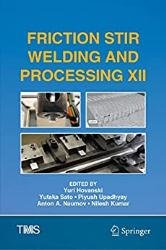 Название: Friction Stir Welding and Processing XII
Название: Friction Stir Welding and Processing XIIАвтор: Yuri Hovanski, Yutaka Sato, Piyush Upadhyay
Издательство: Springer
Год: 2023
Страниц: 267
Язык: английский
Формат: pdf (true)
Размер: 10.2 MB
This collection presents fundamentals and the current status of friction stir welding (FSW) and solid-state friction stir processing of materials and provides researchers and engineers with an opportunity to review the current status of the friction stir related processes and discuss the future possibilities. Contributions cover various aspects of friction stir welding and processing including their derivative technologies.
Aerospace flight panels must provide high strength with low mass. For aluminum panels, it is common practice to begin with a wrought plate and remove the majority of the material to attain the desired structure, comprising a thinner plate with the desired pattern of reinforcement ribs. As an alternative, this study implements hybrid manufacturing, where aluminum is first deposited on a baseplate only at the rib locations using additive friction stir deposition (AFSD). Structured light scanning is then used to measure the printed geometry. This geometry is finally used as the stock model for computer numerical control (CNC) machining. This paper details the hybrid manufacturing process that consists of: AFSD to print the preform, structured light scanning to generate the stock model and tool path, three-axis CNC machining, and post-process measurements for part geometry and microstructure.
Metal additive manufacturing (AM) includes beam-based technologies, such as powder bed fusion and directed energy deposition, as well as wire arc AM. For these processes, the metal powder or wire is melted using a high-intensity heat source and deposited in a layer-by-layer fashion. The gross part geometry is dictated by the computer model fed to the printer, while the microstructure is established during the subsequent solidification and cooling, ultimately dictated by the local temperature gradient and cooling rate. An alternative non-beam-based, solid-state additive process is provided by additive friction stir deposition (AFSD). In this case, no melting occurs, and the geometry and microstructure are defined by the kinetic energy introduced by the AFSD process. In this sense, AFSD microstructure depends on thermomechanical, rather than solidification, mechanisms. Research efforts have included the study of microstructure and its relationship to mechanical properties and operation parameters. Deposition materials have included aluminum, magnesium, copper, and steel alloys, for example.
Topics include, but are not limited to:
• Derivative technologies
• High-temperature applications
• Industrial applications
• Dissimilar alloys and/or materials
• Lightweight alloys
• Simulation
• Characterization
• Non-destructive examination techniques
Скачать Friction Stir Welding and Processing XII